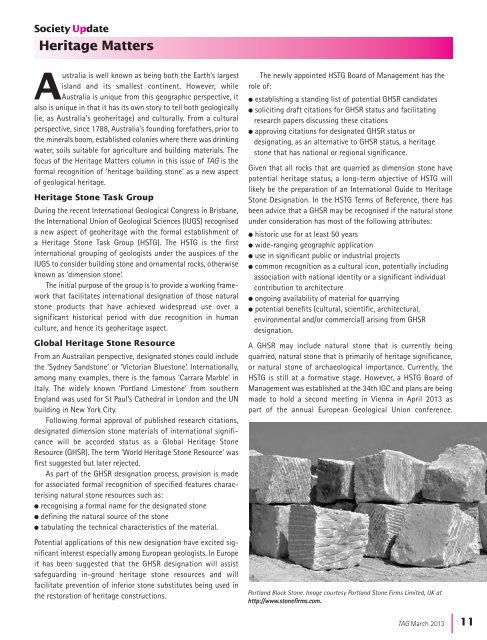TAG 166 - Geological Society of Australia
TAG 166 - Geological Society of Australia
TAG 166 - Geological Society of Australia
Create successful ePaper yourself
Turn your PDF publications into a flip-book with our unique Google optimized e-Paper software.
<strong>Society</strong> UpdateHeritage Matters<strong>Australia</strong> is well known as being both the Earth’s largestisland and its smallest continent. However, while<strong>Australia</strong> is unique from this geographic perspective, italso is unique in that it has its own story to tell both geologically(ie, as <strong>Australia</strong>’s geoheritage) and culturally. From a culturalperspective, since 1788, <strong>Australia</strong>’s founding forefathers, prior tothe minerals boom, established colonies where there was drinkingwater, soils suitable for agriculture and building materials. Thefocus <strong>of</strong> the Heritage Matters column in this issue <strong>of</strong> <strong>TAG</strong> is theformal recognition <strong>of</strong> ‘heritage building stone’ as a new aspect<strong>of</strong> geological heritage.Heritage Stone Task GroupDuring the recent International <strong>Geological</strong> Congress in Brisbane,the International Union <strong>of</strong> <strong>Geological</strong> Sciences (IUGS) recogniseda new aspect <strong>of</strong> geoheritage with the formal establishment <strong>of</strong>a Heritage Stone Task Group (HSTG). The HSTG is the firstinternational grouping <strong>of</strong> geologists under the auspices <strong>of</strong> theIUGS to consider building stone and ornamental rocks, otherwiseknown as ‘dimension stone’.The initial purpose <strong>of</strong> the group is to provide a working frameworkthat facilitates international designation <strong>of</strong> those naturalstone products that have achieved widespread use over asignificant historical period with due recognition in humanculture, and hence its geoheritage aspect.Global Heritage Stone ResourceFrom an <strong>Australia</strong>n perspective, designated stones could includethe ‘Sydney Sandstone’ or ‘Victorian Bluestone’. Internationally,among many examples, there is the famous ‘Carrara Marble’ inItaly. The widely known ‘Portland Limestone’ from southernEngland was used for St Paul’s Cathedral in London and the UNbuilding in New York City.Following formal approval <strong>of</strong> published research citations,designated dimension stone materials <strong>of</strong> international significancewill be accorded status as a Global Heritage StoneResource (GHSR). The term ‘World Heritage Stone Resource’ wasfirst suggested but later rejected.As part <strong>of</strong> the GHSR designation process, provision is madefor associated formal recognition <strong>of</strong> specified features characterisingnatural stone resources such as:l recognising a formal name for the designated stonel defining the natural source <strong>of</strong> the stonel tabulating the technical characteristics <strong>of</strong> the material.Potential applications <strong>of</strong> this new designation have excited significantinterest especially among European geologists. In Europeit has been suggested that the GHSR designation will assistsafeguarding in-ground heritage stone resources and willfacilitate prevention <strong>of</strong> inferior stone substitutes being used inthe restoration <strong>of</strong> heritage constructions.The newly appointed HSTG Board <strong>of</strong> Management has therole <strong>of</strong>:l establishing a standing list <strong>of</strong> potential GHSR candidatesl soliciting draft citations for GHSR status and facilitatingresearch papers discussing these citationsl approving citations for designated GHSR status ordesignating, as an alternative to GHSR status, a heritagestone that has national or regional significance.Given that all rocks that are quarried as dimension stone havepotential heritage status, a long-term objective <strong>of</strong> HSTG willlikely be the preparation <strong>of</strong> an International Guide to HeritageStone Designation. In the HSTG Terms <strong>of</strong> Reference, there hasbeen advice that a GHSR may be recognised if the natural stoneunder consideration has most <strong>of</strong> the following attributes:l historic use for at least 50 yearsl wide-ranging geographic applicationl use in significant public or industrial projectsl common recognition as a cultural icon, potentially includingassociation with national identity or a significant individualcontribution to architecturel ongoing availability <strong>of</strong> material for quarryingl potential benefits (cultural, scientific, architectural,environmental and/or commercial) arising from GHSRdesignation.A GHSR may include natural stone that is currently beingquarried, natural stone that is primarily <strong>of</strong> heritage significance,or natural stone <strong>of</strong> archaeological importance. Currently, theHSTG is still at a formative stage. However, a HSTG Board <strong>of</strong>Management was established at the 34th IGC and plans are beingmade to hold a second meeting in Vienna in April 2013 aspart <strong>of</strong> the annual European <strong>Geological</strong> Union conference.Portland Block Stone. Image courtesy Portland Stone Firms Limited, UK athttp://www.stonefirms.com.<strong>TAG</strong> March 2013| 11
















